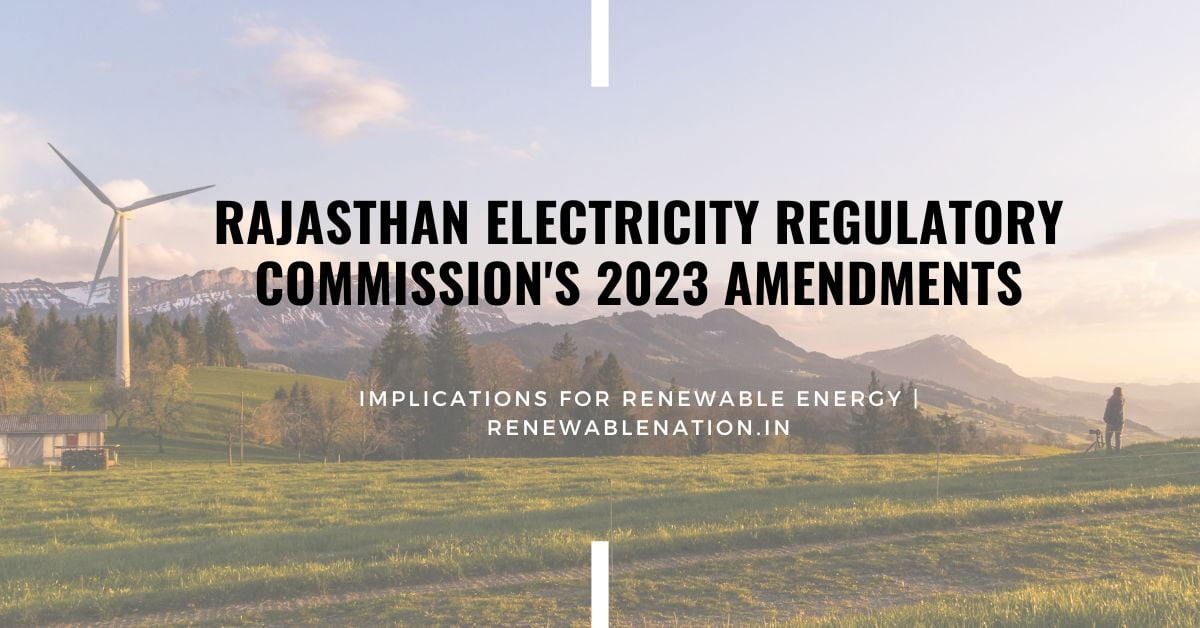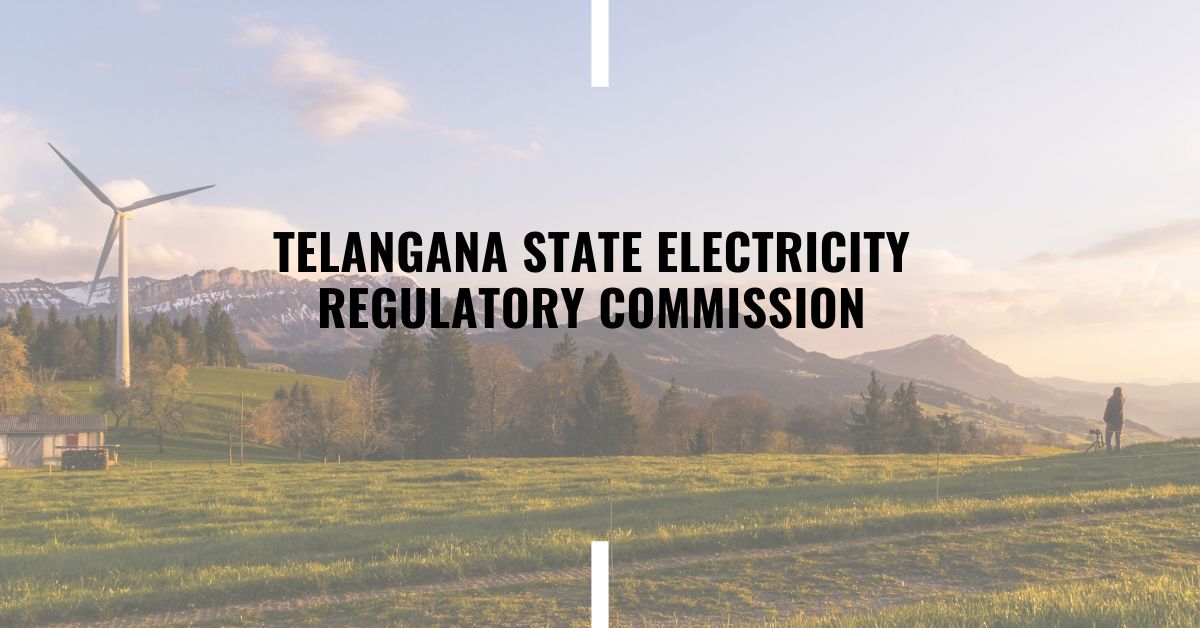The Rajasthan State Electricity Regulatory Commission (RERC) has brought about significant changes to its regulations pertaining to tariff determination from renewable energy sources. These amendments, effective from a specific date in 2023, hold the potential to reshape the renewable energy sector within the state. Let’s delve into the details of these crucial changes and their potential implications for the future of renewable energy in Rajasthan.
Key Amendments Unveiled
Short Title and Commencement
The RERC has introduced a set of regulations titled “Rajasthan Electricity Regulatory Commission (Terms and Conditions for Tariff determination from Renewable Energy Sources) (First Amendment) Regulations, 2023.” These regulations come into force upon their publication in the Official Gazette and draw their authority from the Electricity Act, 2003.
Evolution of Regulation 9
A noteworthy transformation is witnessed in Regulation 9, which now incorporates two new provisos. The first proviso mandates that the Capacity Utilization Factor (CUF) norms for determining project-specific tariffs for projects under sub-regulation 9.1 shall adhere to the minimum norm. The second proviso outlines CUF norms for projects undergoing tariff determination through a transparent bidding process as prescribed by Central Government guidelines under Section 63 of the Act.
Amendments in Regulation 91
Regulation 91 witnesses amendments that offer exemptions in transmission and wheeling charges. For Renewable Energy with Storage projects, a significant 75% exemption in intra-state transmission and wheeling charges is granted for the initial seven years of operation from the project’s commissioning date. Furthermore, Solar Power Projects established post 01.04.2020, intended for supplying power to Electric Vehicle charging stations, enjoy a complete 100% exemption in intra-state transmission and wheeling charges for the initial ten years post the establishment date. It’s worth noting that these exemptions are applicable for projects with an individual plant capacity of up to 25 MW and a total capacity of 500 MW within the state.
Transformation of Regulation 92
Regulation 92 undergoes a fundamental alteration with regards to the calculation of peak AC capacity for renewable energy captive generating plants. The peak AC capacity now aligns with the contracted AC capacity, rendering any excess generation that surpasses this capacity within a specified time block as invalid. This provision, however, does not impose any limitations on the installed DC capacity.
Changes in Regulation 93
Regulation 93, which revolves around energy banking, introduces several amendments. Energy banking is permitted on an annual basis, subject to specific conditions. The energy banking capacity is limited to a maximum of 25% of the energy injected by the Renewable Energy Captive Generating Station in a month or 30% of the total monthly consumption from the distribution licensee, depending on which figure is higher. Exceptions are made for instances where power is supplied to third parties under open access or when green energy is employed for the production of green hydrogen and green ammonia.
Introduction of Regulations 94A, 94B, and 94C
The RERC takes a proactive step in encouraging green energy adoption by introducing new regulations. Regulation 94A enables consumers to purchase green energy up to a specific percentage of their consumption, allowing them to requisition both solar and non-solar energy separately. Consumers can even opt to procure more renewable energy voluntarily, going beyond their mandatory quota. The tariff for this green energy is determined by the Commission through a distinct order, considering various cost components of the Distribution Licensee. Moreover, the distribution licensees are mandated to issue green certificates annually to consumers purchasing green energy beyond their renewable purchase obligation, as stipulated by Regulation 94B. In addition, Regulation 94C introduces the concept of consumer rating based on the percentage of green energy purchased.
Implications and Way Forward
The amendments instituted by the Rajasthan Electricity Regulatory Commission signify a profound shift in the state’s approach towards renewable energy. By incentivizing green energy adoption through favorable tariff structures, exemptions, and energy banking mechanisms, the state envisions an accelerated transition towards cleaner and more sustainable energy sources. These amendments bear the potential to not only reshape the energy sector but also redefine Rajasthan’s environmental and economic landscape.
As these amendments take root, various stakeholders, including consumers, distribution licensees, and developers of renewable energy projects, are anticipated to navigate these changes. The proactive stance adopted by the RERC underscores Rajasthan’s commitment to realizing its renewable energy ambitions and contributing to a greener future.
To conclude, the Rajasthan Electricity Regulatory Commission’s 2023 Amendments usher in a new era for renewable energy in the state. These amendments set the stage for amplified renewable energy capacity, reduced carbon emissions, and an overall sustainable energy landscape in Rajasthan. As stakeholders adapt to these changes, the journey towards a cleaner and greener energy future for Rajasthan gains momentum.
Rajasthan Electricity Regulatory Commission’s 2023 Amendments: Implications for Renewable Energy
The Rajasthan State Electricity Regulatory Commission (RERC) has brought about significant changes to its regulations pertaining to tariff determination from renewable energy sources. These amendments, effective from a specific date in 2023, hold the potential to reshape the renewable energy sector within the state. Let’s delve into the details of these crucial changes and their potential implications for the future of renewable energy in Rajasthan.
Key Amendments Unveiled
Short Title and Commencement
The RERC has introduced a set of regulations titled “Rajasthan Electricity Regulatory Commission (Terms and Conditions for Tariff determination from Renewable Energy Sources) (First Amendment) Regulations, 2023.” These regulations come into force upon their publication in the Official Gazette and draw their authority from the Electricity Act, 2003.
Evolution of Regulation 9
A noteworthy transformation is witnessed in Regulation 9, which now incorporates two new provisos. The first proviso mandates that the Capacity Utilization Factor (CUF) norms for determining project-specific tariffs for projects under sub-regulation 9.1 shall adhere to the minimum norm. The second proviso outlines CUF norms for projects undergoing tariff determination through a transparent bidding process as prescribed by Central Government guidelines under Section 63 of the Act.
Amendments in Regulation 91
Regulation 91 witnesses amendments that offer exemptions in transmission and wheeling charges. For Renewable Energy with Storage projects, a significant 75% exemption in intra-state transmission and wheeling charges is granted for the initial seven years of operation from the project’s commissioning date. Furthermore, Solar Power Projects established post 01.04.2020, intended for supplying power to Electric Vehicle charging stations, enjoy a complete 100% exemption in intra-state transmission and wheeling charges for the initial ten years post the establishment date. It’s worth noting that these exemptions are applicable for projects with an individual plant capacity of up to 25 MW and a total capacity of 500 MW within the state.
Transformation of Regulation 92
Regulation 92 undergoes a fundamental alteration with regards to the calculation of peak AC capacity for renewable energy captive generating plants. The peak AC capacity now aligns with the contracted AC capacity, rendering any excess generation that surpasses this capacity within a specified time block as invalid. This provision, however, does not impose any limitations on the installed DC capacity.
Changes in Regulation 93
Regulation 93, which revolves around energy banking, introduces several amendments. Energy banking is permitted on an annual basis, subject to specific conditions. The energy banking capacity is limited to a maximum of 25% of the energy injected by the Renewable Energy Captive Generating Station in a month or 30% of the total monthly consumption from the distribution licensee, depending on which figure is higher. Exceptions are made for instances where power is supplied to third parties under open access or when green energy is employed for the production of green hydrogen and green ammonia.
Introduction of Regulations 94A, 94B, and 94C
The RERC takes a proactive step in encouraging green energy adoption by introducing new regulations. Regulation 94A enables consumers to purchase green energy up to a specific percentage of their consumption, allowing them to requisition both solar and non-solar energy separately. Consumers can even opt to procure more renewable energy voluntarily, going beyond their mandatory quota. The tariff for this green energy is determined by the Commission through a distinct order, considering various cost components of the Distribution Licensee. Moreover, the distribution licensees are mandated to issue green certificates annually to consumers purchasing green energy beyond their renewable purchase obligation, as stipulated by Regulation 94B. In addition, Regulation 94C introduces the concept of consumer rating based on the percentage of green energy purchased.
Implications and Way Forward
The amendments instituted by the Rajasthan Electricity Regulatory Commission signify a profound shift in the state’s approach towards renewable energy. By incentivizing green energy adoption through favorable tariff structures, exemptions, and energy banking mechanisms, the state envisions an accelerated transition towards cleaner and more sustainable energy sources. These amendments bear the potential to not only reshape the energy sector but also redefine Rajasthan’s environmental and economic landscape.
As these amendments take root, various stakeholders, including consumers, distribution licensees, and developers of renewable energy projects, are anticipated to navigate these changes. The proactive stance adopted by the RERC underscores Rajasthan’s commitment to realizing its renewable energy ambitions and contributing to a greener future.
To conclude, the Rajasthan Electricity Regulatory Commission’s 2023 Amendments usher in a new era for renewable energy in the state. These amendments set the stage for amplified renewable energy capacity, reduced carbon emissions, and an overall sustainable energy landscape in Rajasthan. As stakeholders adapt to these changes, the journey towards a cleaner and greener energy future for Rajasthan gains momentum.










